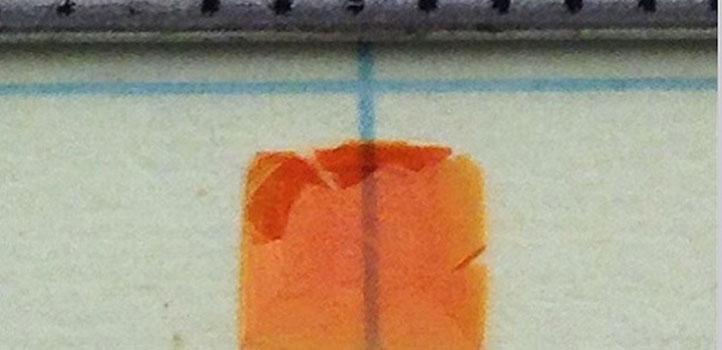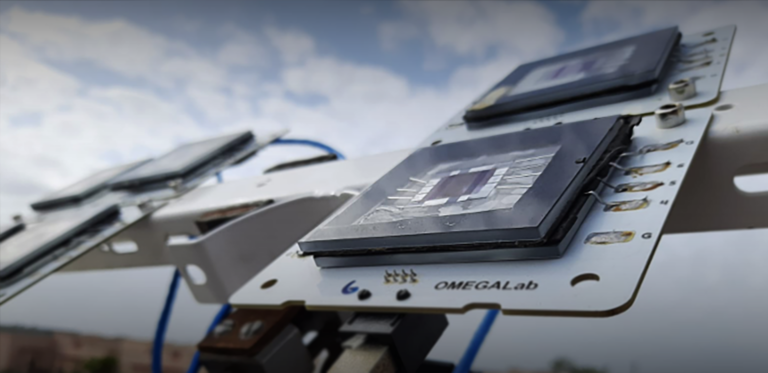Material Science and Engineering
A little tension yields enormous solar crystals
New evidence of surface-initiated crystallization may improve the efficiency of printable photovoltaic materials.


In-depth analysis of the mechanisms that generate floating crystals from hot liquids could lead to large-scale, printable solar cells
Reproduced with permission from reference 1© 2017 American Chemical Society
In the race to replace silicon in low-cost solar cells, semiconductors known as metal halide perovskites are favored because they can be solution-processed into thin films with excellent photovoltaic efficiency. A collaboration between KAUST and Oxford University researchers has now uncovered a strategy that grows perovskites into centimeter-scale, highly pure crystals thanks to the effect of surface tension.
In their natural state, perovskites have difficultly moving solar-generated electricity because they crystallize with randomly oriented grains. Osman Bakr from KAUST’s Solar Center and coworkers are working on ways to dramatically speed up the flow of these charge carriers using inverse temperature crystallization (ITC). This technique uses special organic liquids and thermal energy to force perovskites to solidify into structures resembling single crystals—the optimal arrangements for device purposes.
While ITC produces high-quality perovskites far faster than conventional chemical methods, the curious mechanisms that initiate crystallization in hot organic liquids are poorly understood. Ayan Zhumekenov, a PhD student in Bakr’s group, recalls spotting a key piece of evidence during efforts to adapt ITC toward large-scale manufacturing. “At some point, we realized that when crystals appeared, it was usually at the solution’s surface,” he says. “And this was particularly true when we used concentrated solutions.”
The KAUST team partnered with Oxford theoreticians to identify how interfaces influence perovskite growth in ITC. They propose that metal halides and solvent molecules initially cling together in tight complexes that begin to stretch and weaken at higher temperatures. With sufficient thermal energy, the complex breaks and perovskites begin to crystallize.
But interestingly, the researchers found that complexes located at the solution surface can experience additional forces due to surface tension—the strong cohesive forces that enable certain insects to stride over lakes and ponds. The extra pull provided by the surface makes it much easier to separate the solvent-perovskite complexes and nucleate crystals that float on top of the liquid.
Exploiting this knowledge helped the team produce centimeter-sized, ultrathin single crystals and prototype a photodetector with characteristics comparable to state-of-the-art devices. Although the single crystals are currently fragile and difficult to handle due to their microscale thicknesses, Zhumekenov explains that this method could help direct the perovskite growth onto specific substrates.
“Taking into account the roles of interfaces and surface tension could have a fundamental impact,” he says, “we can get large-area growth, and it’s not limited to specific metal cations—you could have a library of materials with perovskite structures.”
References
- Zhumekenov, A. A., Burlakov, V. M., Saidaminov, M. I., Alofi, A., Haque, M.-A.…Bakr, O.M. The role of surface tension in the crystallization of metal halide perovskites. ACS Energy Letters 2, 1782–1788 (2017).| article
You might also like

Material Science and Engineering
Electron movie guides design of layered perovskite materials

Material Science and Engineering
Remote region sensor for essential vitamin deficiency

Material Science and Engineering
Low-power hydrogen sensor detects leaks in an instant

Material Science and Engineering
Illuminating pathways to long-lived organic solar cells

Chemistry
Beating the dark current for safer X-ray imaging

Chemical Engineering
Net benefits for advanced materials design

Material Science and Engineering
Atom-thin insulator grown into perfect films

Material Science and Engineering



